+ Open data
Open data
- Basic information
Basic information
| Entry | Database: PDB / ID: 7et3 | |||||||||||||||||||||||||||
|---|---|---|---|---|---|---|---|---|---|---|---|---|---|---|---|---|---|---|---|---|---|---|---|---|---|---|---|---|
| Title | C5 portal vertex in the enveloped virion capsid | |||||||||||||||||||||||||||
 Components Components |
| |||||||||||||||||||||||||||
 Keywords Keywords | VIRAL PROTEIN / C5 portal vertex / enveloped capsid | |||||||||||||||||||||||||||
| Function / homology |  Function and homology information Function and homology informationviral genome packaging / T=16 icosahedral viral capsid / viral tegument / viral capsid assembly / viral release from host cell / viral process / chromosome organization / viral capsid / symbiont-mediated perturbation of host ubiquitin-like protein modification / cysteine-type deubiquitinase activity ...viral genome packaging / T=16 icosahedral viral capsid / viral tegument / viral capsid assembly / viral release from host cell / viral process / chromosome organization / viral capsid / symbiont-mediated perturbation of host ubiquitin-like protein modification / cysteine-type deubiquitinase activity / host cell cytoplasm / host cell nucleus / structural molecule activity / proteolysis / DNA binding Similarity search - Function | |||||||||||||||||||||||||||
| Biological species |   Human cytomegalovirus Human cytomegalovirus | |||||||||||||||||||||||||||
| Method | ELECTRON MICROSCOPY / single particle reconstruction / cryo EM / Resolution: 4.2 Å | |||||||||||||||||||||||||||
 Authors Authors | Li, Z. / Yu, X. | |||||||||||||||||||||||||||
| Funding support |  China, 1items China, 1items
| |||||||||||||||||||||||||||
 Citation Citation |  Journal: Nat Commun / Year: 2021 Journal: Nat Commun / Year: 2021Title: Structural basis for genome packaging, retention, and ejection in human cytomegalovirus. Authors: Zhihai Li / Jingjing Pang / Lili Dong / Xuekui Yu /  Abstract: How the human cytomegalovirus (HCMV) genome-the largest among human herpesviruses-is packaged, retained, and ejected remains unclear. We present the in situ structures of the symmetry-mismatched ...How the human cytomegalovirus (HCMV) genome-the largest among human herpesviruses-is packaged, retained, and ejected remains unclear. We present the in situ structures of the symmetry-mismatched portal and the capsid vertex-specific components (CVSCs) of HCMV. The 5-fold symmetric 10-helix anchor-uncommon among known portals-contacts the portal-encircling DNA, which is presumed to squeeze the portal as the genome packaging proceeds. We surmise that the 10-helix anchor dampens this action to delay the portal reaching a "head-full" packaging state, thus facilitating the large genome to be packaged. The 6-fold symmetric turret, latched via a coiled coil to a helix from a major capsid protein, supports the portal to retain the packaged genome. CVSCs at the penton vertices-presumed to increase inner capsid pressure-display a low stoichiometry, which would aid genome retention. We also demonstrate that the portal and capsid undergo conformational changes to facilitate genome ejection after viral cell entry. | |||||||||||||||||||||||||||
| History |
|
- Structure visualization
Structure visualization
| Movie |
 Movie viewer Movie viewer |
|---|---|
| Structure viewer | Molecule:  Molmil Molmil Jmol/JSmol Jmol/JSmol |
- Downloads & links
Downloads & links
- Download
Download
| PDBx/mmCIF format |  7et3.cif.gz 7et3.cif.gz | 1.9 MB | Display |  PDBx/mmCIF format PDBx/mmCIF format |
|---|---|---|---|---|
| PDB format |  pdb7et3.ent.gz pdb7et3.ent.gz | 1.5 MB | Display |  PDB format PDB format |
| PDBx/mmJSON format |  7et3.json.gz 7et3.json.gz | Tree view |  PDBx/mmJSON format PDBx/mmJSON format | |
| Others |  Other downloads Other downloads |
-Validation report
| Summary document |  7et3_validation.pdf.gz 7et3_validation.pdf.gz | 1.4 MB | Display |  wwPDB validaton report wwPDB validaton report |
|---|---|---|---|---|
| Full document |  7et3_full_validation.pdf.gz 7et3_full_validation.pdf.gz | 1.5 MB | Display | |
| Data in XML |  7et3_validation.xml.gz 7et3_validation.xml.gz | 250.9 KB | Display | |
| Data in CIF |  7et3_validation.cif.gz 7et3_validation.cif.gz | 396.6 KB | Display | |
| Arichive directory |  https://data.pdbj.org/pub/pdb/validation_reports/et/7et3 https://data.pdbj.org/pub/pdb/validation_reports/et/7et3 ftp://data.pdbj.org/pub/pdb/validation_reports/et/7et3 ftp://data.pdbj.org/pub/pdb/validation_reports/et/7et3 | HTTPS FTP |
-Related structure data
| Related structure data |  31297MC  7et2C  7etjC  7etmC  7etoC M: map data used to model this data C: citing same article ( |
|---|---|
| Similar structure data |
- Links
Links
- Assembly
Assembly
| Deposited unit | 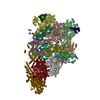
|
|---|---|
| 1 | x 5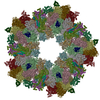
|
| 2 |
|
| 3 | 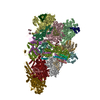
|
| Symmetry | Point symmetry: (Schoenflies symbol: C5 (5 fold cyclic)) |
- Components
Components
-Triplex capsid protein ... , 2 types, 6 molecules hInogm
| #1: Protein | Mass: 34635.750 Da / Num. of mol.: 4 / Source method: isolated from a natural source / Source: (natural)   Human cytomegalovirus / References: UniProt: Q6RXF2 Human cytomegalovirus / References: UniProt: Q6RXF2#3: Protein | Mass: 33071.270 Da / Num. of mol.: 2 / Source method: isolated from a natural source / Source: (natural)   Human cytomegalovirus / References: UniProt: Q6RXH2 Human cytomegalovirus / References: UniProt: Q6RXH2 |
|---|
-Protein , 4 types, 14 molecules HP1RSTijaBCDYZ
| #2: Protein | Mass: 253541.141 Da / Num. of mol.: 2 / Source method: isolated from a natural source / Source: (natural)   Human cytomegalovirus Human cytomegalovirusReferences: UniProt: A0A3G6XL22, ubiquitinyl hydrolase 1, Hydrolases; Acting on peptide bonds (peptidases); Cysteine endopeptidases #6: Protein | | Mass: 112829.102 Da / Num. of mol.: 1 / Source method: isolated from a natural source / Source: (natural)   Human cytomegalovirus / References: UniProt: A0A6C0PKC1 Human cytomegalovirus / References: UniProt: A0A6C0PKC1#7: Protein | Mass: 8495.924 Da / Num. of mol.: 5 / Source method: isolated from a natural source / Source: (natural)   Human cytomegalovirus / References: UniProt: A8T7C4 Human cytomegalovirus / References: UniProt: A8T7C4#8: Protein | Mass: 154048.906 Da / Num. of mol.: 6 / Source method: isolated from a natural source / Source: (natural)   Human cytomegalovirus / References: UniProt: A0A1U8QPG3 Human cytomegalovirus / References: UniProt: A0A1U8QPG3 |
|---|
-Capsid vertex component ... , 2 types, 3 molecules MNO
| #4: Protein | Mass: 68567.211 Da / Num. of mol.: 1 / Source method: isolated from a natural source / Source: (natural)   Human cytomegalovirus / References: UniProt: A0A6C0PJD3 Human cytomegalovirus / References: UniProt: A0A6C0PJD3 |
|---|---|
| #5: Protein | Mass: 71269.570 Da / Num. of mol.: 2 / Source method: isolated from a natural source / Source: (natural)   Human cytomegalovirus / References: UniProt: A0A3G6XKK5 Human cytomegalovirus / References: UniProt: A0A3G6XKK5 |
-Details
| Has protein modification | Y |
|---|
-Experimental details
-Experiment
| Experiment | Method: ELECTRON MICROSCOPY |
|---|---|
| EM experiment | Aggregation state: PARTICLE / 3D reconstruction method: single particle reconstruction |
- Sample preparation
Sample preparation
| Component | Name: Human betaherpesvirus 5 / Type: VIRUS / Entity ID: all / Source: NATURAL |
|---|---|
| Source (natural) | Organism:   Human betaherpesvirus 5 Human betaherpesvirus 5 |
| Details of virus | Empty: NO / Enveloped: YES / Isolate: STRAIN / Type: VIRION |
| Buffer solution | pH: 7.5 |
| Specimen | Embedding applied: NO / Shadowing applied: NO / Staining applied: NO / Vitrification applied: YES |
| Vitrification | Cryogen name: ETHANE |
- Electron microscopy imaging
Electron microscopy imaging
| Experimental equipment |  Model: Titan Krios / Image courtesy: FEI Company |
|---|---|
| Microscopy | Model: FEI TITAN KRIOS |
| Electron gun | Electron source:  FIELD EMISSION GUN / Accelerating voltage: 300 kV / Illumination mode: FLOOD BEAM FIELD EMISSION GUN / Accelerating voltage: 300 kV / Illumination mode: FLOOD BEAM |
| Electron lens | Mode: BRIGHT FIELD |
| Image recording | Electron dose: 30 e/Å2 / Film or detector model: GATAN K3 BIOQUANTUM (6k x 4k) |
- Processing
Processing
| Software | Name: PHENIX / Version: 1.14_3260: / Classification: refinement |
|---|---|
| EM software | Name: PHENIX / Category: model refinement |
| CTF correction | Type: PHASE FLIPPING AND AMPLITUDE CORRECTION |
| 3D reconstruction | Resolution: 4.2 Å / Resolution method: FSC 0.143 CUT-OFF / Num. of particles: 23136 / Symmetry type: POINT |
 Movie
Movie Controller
Controller













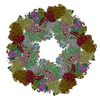

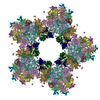

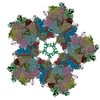

 PDBj
PDBj
